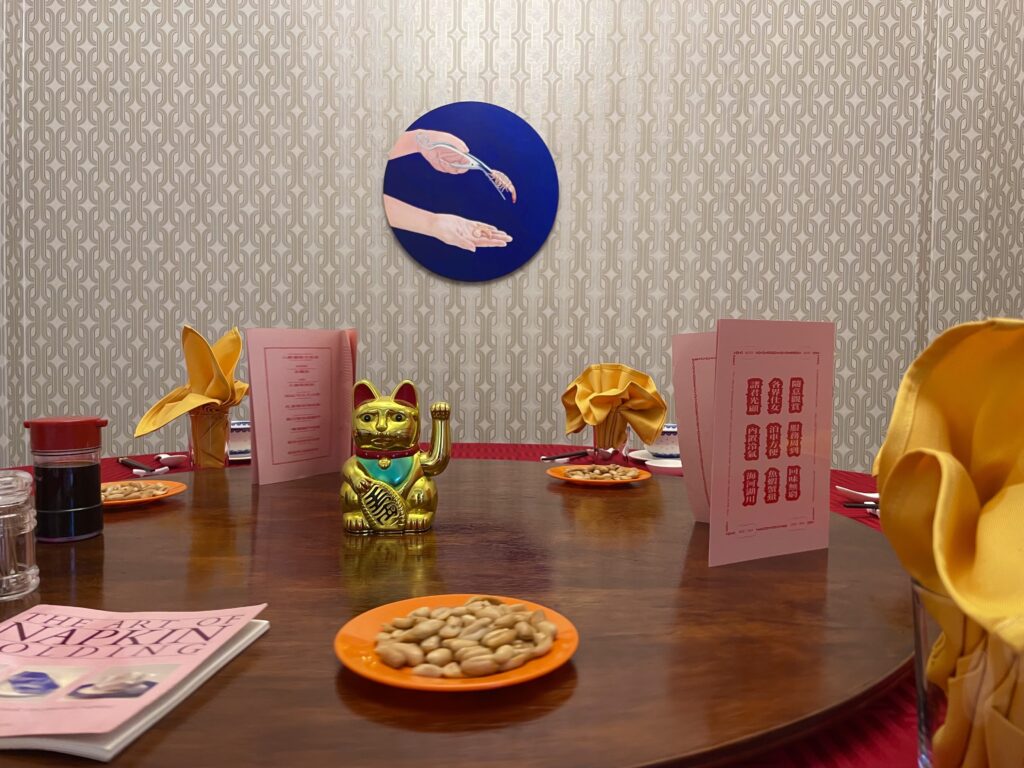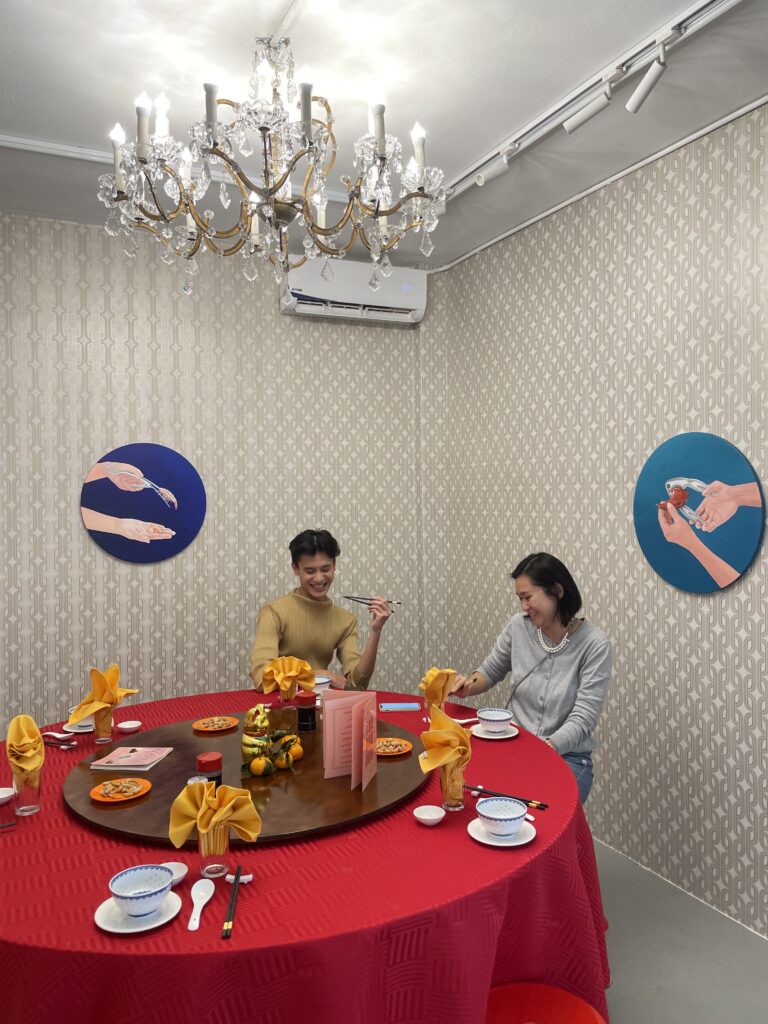26 Apr 2022
Interview
FAN CHON HOO: FISHING LURES
Upon arrival to Suomenlinna, Fan Chon Hoo was intrigued by the salmon pink building by the main pier of Iso Mustasaari. “Do Finnish people love salmon so much that they paint their houses pink?”, he wondered. Through research, Fan Chon discovered that the colour was in fact Russian influenced but Italy inspired; the pink stone barracks, built in 1868–70, dated back to the Russian era, and Russian architecture during that time was strongly influenced by Mediterranean styles. Similar pink hues can be found in Estonia, and also Norway, to an extent.
The colour, salmon pink, felt like a sign. Fan Chon had been trying to break away from his obsession with fish, yet here he was again, staring at the topic through colour. Recently he had explored the topic of fish in detail in his exhibition “The World is Your Restaurant” in Kuala Lumpur. While Fan Chon usually intends to detach himself from his work and autobiography, a question asked by a curator forced him to look at his own past and his social class through the topic of Chinese banquets and eating together. Fan Chon grew up the son of a middle-class fisherman, who always made sure there was plenty of fish on the table and held a lot of fish related wisdom. This wisdom, this knowledge was passed on to Fan Chon, who now views the world in a certain way thanks to or because of his father. The exhibition reflected Fan Chon’s relationship with his father, and also with fish.

Fan Chon Hoo visited the Salmon center in Oslo during his residency, a salmon-themed restaurant with a dedicated exhibition about salmon aquaculture in Norway.
During his stay at Suomenlinna, Fan Chon took a trip to Norway and visited The Salmon science centre in Oslo as well as the Norwegian Fisheries Museum in Bergen, hoping to see a real swimming salmon up close, which he hadn’t had the chance to see before. Class as well as origin and cultural notions of ‘taste’ are also central to Fan Chon’s investigation. Since Suomenlinna pulled him back to researching fish, he has been curious about the European way of choosing to eat a certain type of salmon. Farmed salmon, naturally white or grey in colour, is coloured pink to resemble wild salmon. Some Europeans are then making a choice to eat for example only wild salmon, instead of farmed; this is a privileged position, Fan Chon argues, being able to choose. In the Asian context, eating salmon of any kind is already seen as a posh, Western activity; eating salmon is already a comment on wanting to be seen as part of a global middle class, and choosing between wild and farmed salmon in that context is impossible. The working title for Fan Chon’s research residency project is “Let them eat salmon”, referencing of course the famous quote by (allegedly) Marie Antoinette who failed to see that the people she was referring to did not have the same options as her. The results of the research will be exhibited in Singapore later this year.

A simulated salmon farming control center at the exhibition.
AA: Strong sensations may often bring back memories. Do you intentionally evoke memories of past banquets through your work?
FCH: I was trying to understand my fascination with fish through my last solo exhibition “The World Is Your Restaurant” (2022), naturally it took an introspective approach by drawing inspiration from my childhood memories of growing up in a fishing village and experiences of attending Chinese banquet services.

“The World Is Your Restaurant” installation shot, The Back Room Kuala Lumpur 2022. Acrylic paintings, Chinese banquet dining table with self-rotating Lazy Susan, chandelier, dimension variable.
AA: When discussing the past and tradition, one inevitably thinks about the passage of time. Do you feel your work may act as a bridge between tradition and the future?
FCH: Tradition evolves through time to stay relevant to contemporary socio-cultural conditions. Not consciously so, but you can say that some of my projects intend to reflect on some of our traditional values through appropriation, the perspective of class aspiration, and sometimes personal romantic speculation.
AA: You were born into a fisherman’s family. What is your relationship with the sea?
FCH: As a kid, I wasn’t allowed to swim in the sea or go out in the fishing boat. I suppose my grandparents then didn’t want their grandkids to grow up being fishing men. Life was hard for them. But I do have a strong affinity with island life, houses on stilts, and the smell of the sea on a hot summer day.
AA: How do you feel our taste is shaped by our environment? Can our sense of taste be re-evaluated in a less familiar culture?
FCH: Our socio-cultural conditions and class position play an important role in shaping and informing our aesthetics, ideologies, material preferences, and cultural values. Only when we immerse ourselves in a foreign environment, we are compelled to confront our value systems and sometimes renegotiate them.
AA: What do you think happens when work that is strongly tied to a place, a tradition, gets displaced? How do you think your stay in Suomenlinna may influence your work?
FCH: I often respond to a new place, city, or cultural artefact by searching for something that is seemingly familiar yet foreign; then I will try to find entry points for myself and the audience to engage in a particular subject. It is inevitable that some cultural contexts may be displaced in the process, but sometimes it could also be productive mistranslations, to generate new versions of thinking around the same subject.
I am still trying to process my residency experience in a century-old nordic fortress island. I’ve mostly been based in city centres, though Suomenlinna is just a 15-minute ferry ride from Helsinki, the moment you arrive you’re in a different landscape and it feels remote. It instilled a sense of slowness since the only way to move around the island for most people is by walking. I think I might miss the solitude and silence here when I return to my home in George Town, Penang.

“The World Is Your Restaurant” installation shot, The Back Room Kuala Lumpur 2022. Acrylic paintings, Chinese banquet dining table with self-rotating Lazy Susan, chandelier, dimension variable.
Fan Chon Hoo’s residency is realised in context of SEA AiR – Studio Residencies for Southeast Asian Artists, a collaboration between NTU Centre for Contemporary Art (Singapore), HIAP (Helsinki), Villa Arson (Nice) and WIELS (Brussels).
All photos courtesy of Fan Chon Hoo.
More:
Bureau of Visual Culture George Town zine, 2019.
My Earthy Taste music video, 2018.
